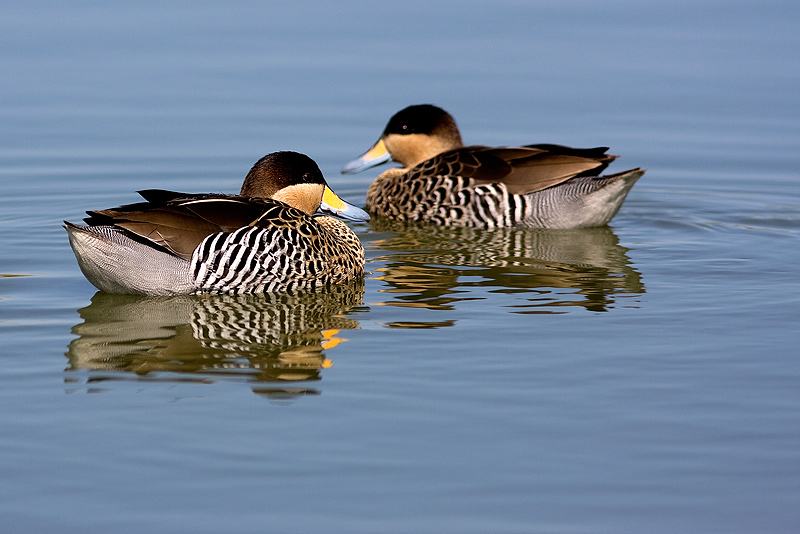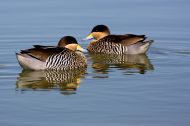Silver Teal
Pato Capuchino
Anas versicolor
Length: 430mm. Sexes alike. Bill light blue on apical half, nail and culmen black, yellow basal patch; iris dark brown; hood dark brown to blackish; rest of head and neck ochraceous buff with fine brown barring on neck; chin and throat blackish; breast and anterior flanks ochraceous buff with abundant very dark brown mottling; posterior flanks barred white and black. Abdomen and under tail coverts white very finely barred blackish. Upper back and lesser scapulars feathers dark brown with buffy margins and semicircles of whitish buff; posterior scapulars olive brown with ochraceous band or stripe on inner vexillum and along feather rachis; lower back, rump and uppertail coverts alternatively black and white barring; rectrices white with very fine blackish barring, giving grey appearance. Lesser and median wing coverts bluish plumbeous-grey; greater coverts brownish grey with broad white terminal band; primaries greyish brown; secondaries glossed with metallic green grading to blue, subterminal blackish band and terminal white band; lesser underwing coverts brownish grey; median, greater underwing coverts and axillaries white. Legs olive grey.
Females are slightly smaller than males and duller; young have plumage with browner barring and mottling, less distinct than adults; scapulars are not striated; hood is brown and speculum is not as glossy.
The adult male’s neck is thicker than the female’s due to the dilated windpipe; the bill is also longer. Habitat and behaviour: the Silver Teal is tame and silent, vocalisations are weak and barely audible; it occurs in pairs or in small groups; frequently found alongside other species of ducks.
This species occurs in shallow ponds, streams, lake shores and marshes, always with abundant emergent and nonemergent vegetation. The Silver Teal feeds on seeds and plants, supplementing diet with insects, their larvae and water invertebrates. Nests among rushes or dense vegetation, well concealed and near the water; as with all ducks, it uses its own down to line the nest; up to ten pink cream eggs are laid; both parents share brooding and caring of the chicks. During very cold winters, after heavy snows and frosts, large groups feed in streams and ponds that had not frozen. On June 1961 the authors spotted flocks of more than 400 individuals in Tecka and Corcovado in Chubut. Range: the Silver Teal is distributed all over Patagonia, represented by two races: Anas versicolor versicolor in Neuquén, Río Negro and east of Chubut; also in the north: in Corrientes, Santa Fe, Santiago del Estero and Tucumán. The other race, A. versicolor fretensis, breeds south of Río Negro and Chubut to Tierra del Fuego and Islas Malvinas.
Illustrated Handbook of the Birds of Patagonia
Kindless: Kovacs Family
|









